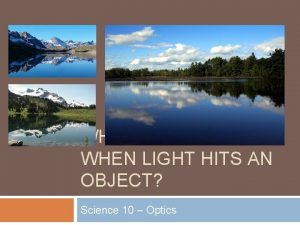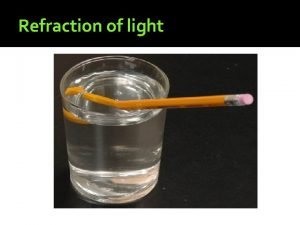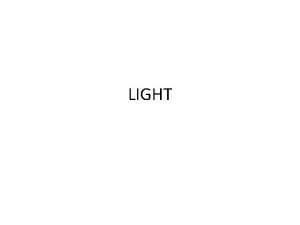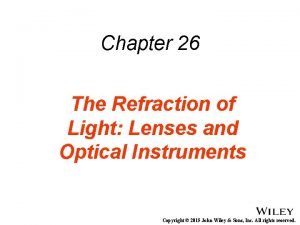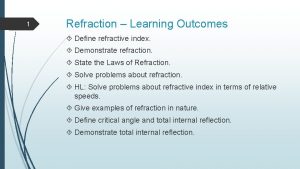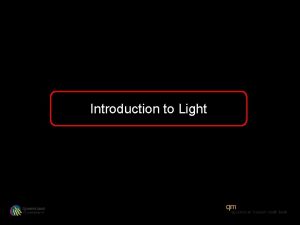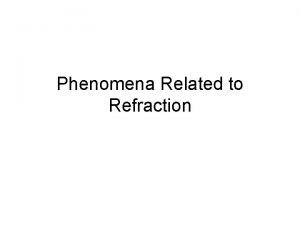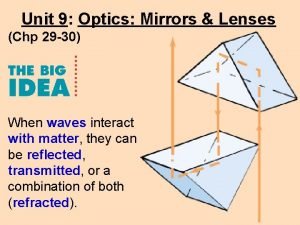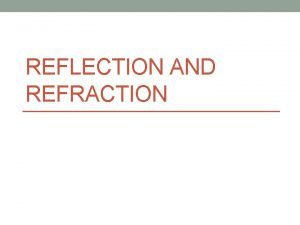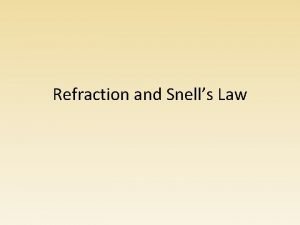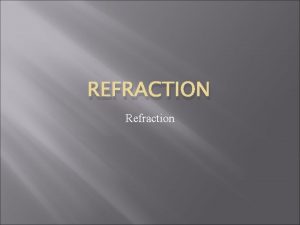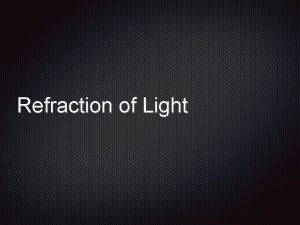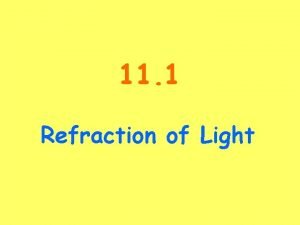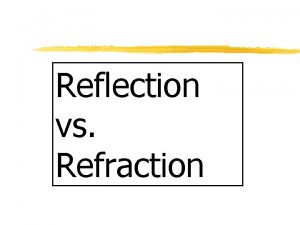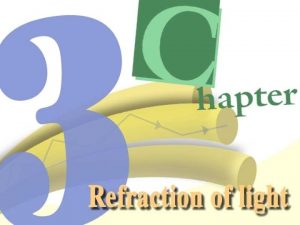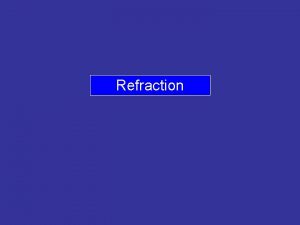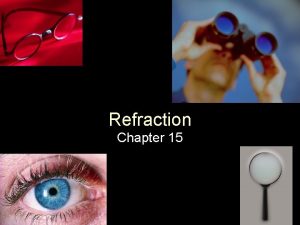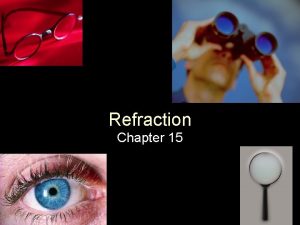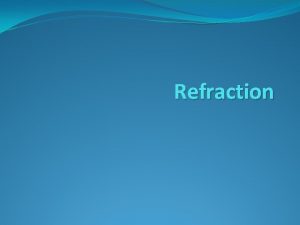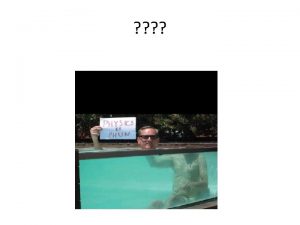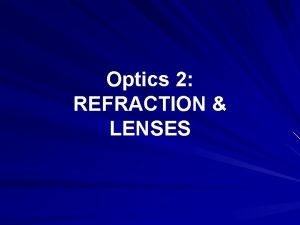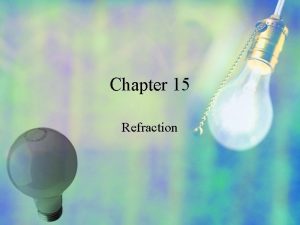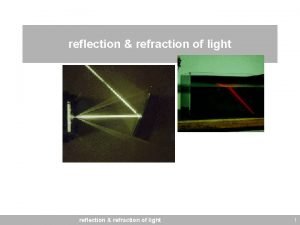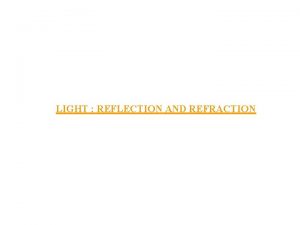REFRACTION OF LIGHT 1 WE CAN SEE REFRACTION

















- Slides: 17

REFRACTION OF LIGHT 1

WE CAN SEE REFRACTION PROPERTY IN GLASS 2

What is refraction? • Refraction is bending of a ray at a boundary due to a different speed of light in the substance. Air Water Demo: tank, laser pointer 3

Why does the ray bend? Hi gh Hi er i gh nd er ex ind Hi ex gh ind ex Incident ray • The incident ray has peaks and troughs in the wave. • The wave that hits the material first slows down. • Causes the wave to bend. Just like waves hitting the shoreline. • Analogy with car driving (twee wheels on a slippery part of the road) …

Why does the ray bend? • Refraction is bending of a ray at a boundary due to a different speed of light in the substance. Air Water Demo: tank, laser pointer Towards or away from the interface 5

Snell’s law n 1 sin q 1 = n 2 sin q 2 Air n 1 = 1. 0003 q 1 q 2 Water n 2 = 1. 33 6

Refraction - bending of a ray after it enters a medium where its speed is different • A ray going from a fast medium to a slow medium bends towards the normal • A ray going from a slow to a fast medium bends away from the normal • Hence, a ray going into a medium with a higher n bends towards the normal & a ray going into a medium with a lower n bends away from the normal Normal Air (fast medium) Glass or water (slow) Normal nair < nwater 1. 0008 < 1. 33 Air (fast medium) Glass or water (slow) How about light going into a medium with exactly the same n?

Light coming out of water: 2 possibilities Refraction out OR Total internal reflection! Refracted Air Water Reflected internally The critical angle is about 42 degrees. Case 1 near normal incidence (light comes out) Case 2, far from normal incidence (internal reflection) Demo: tank, laser pointer 8

Total internal reflection • Show that the internal reflection is a consequence of the Snell’s law • The amount of bending is determined by the law of refraction (sometimes called Snell's law): • ni sinqi = nt sinqt

Total internal reflection - extreme case of a ray bending away from the normal as it goes from higher to lower n Just below the critical angle for total internal reflection there is a reflected Normal& a transmitted ray Air (fast medium) Glass or water Critical(slow) angle Above the critical angle for total internal reflection there is reflected ray but no transmitted ray Normal For the glass-air interface Glass or water (slow)

Ray-bending & our psychological straight-ray interpretation • To observe the fish from outside the water a transmitted ray must enter your eye • You will think it comes from a point obtained by tracing it backwards, • Extend any 2 of the many transmitted rays from the fish backwards to find the image of the fish (where they intersect). • The location of that image will be the same for any observer outside of the water. normal transmitted ray image of fish for someone out of water fish incident ray

What we see and how different it can be from what it seems to be Two observers, one above the water and one under the water, view an object (fellow to the left)… • The woman will see the underwater part of body being a) Smaller than it really is; b) Much larger than it really is; c) Of natural size;

What we see and how different it can be from what it seems to be • The woman will see the underwater part of body being a) Smaller than it really is; b) Much larger than it really is; c) Of natural size;

What we see and how different it can be from what it seems to be Two observers, one above the water and one under the water, view an object (fellow to the left)… • The boy will see the underwater part of body being a) Smaller than it really is; b) Much larger than it really is; c) Of natural size; d) Something else.

What we see and how different it can be from what it seems to be • If the critical angle condition is satisfied, will the boy see the upper part of the man’s body? a) Yes; b) No.

What we see and how different it can be from what it seems to be • The boy will see the underwater part of body being a) Smaller than it really is; b) Much larger than it really is; c) Of natural size; d) Something else. Legs up and down!

REFERENCES • From NCERT book. • From google. 17
 What happens to light when it hits an object.
What happens to light when it hits an object. Light light light chapter 23
Light light light chapter 23 Into the light chapter 22
Into the light chapter 22 Chapter 22
Chapter 22 Shall i compare thee to a summer's day figures of speech
Shall i compare thee to a summer's day figures of speech What material blocked the light
What material blocked the light Lateral displacement formula
Lateral displacement formula A lens that curve outwards and are fatter in the middle
A lens that curve outwards and are fatter in the middle Refraction of light in lenses
Refraction of light in lenses Laws of refraction
Laws of refraction Reflection refraction absorption transmission
Reflection refraction absorption transmission Introduction of light reflection and refraction
Introduction of light reflection and refraction Refraction phenomena
Refraction phenomena Refraction of light
Refraction of light Refraction of light
Refraction of light Refraction of light
Refraction of light Mirage
Mirage Practice noise light and litter discipline cit
Practice noise light and litter discipline cit
